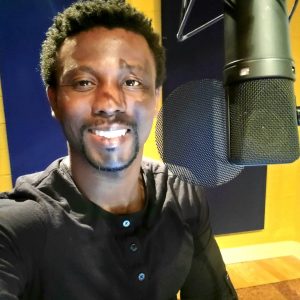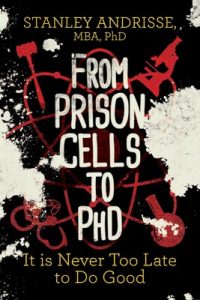
Stanley Andrisse, PhD, MBA, was labeled a career criminal in his early 20s before he was sent to prison for drug trafficking. Last month, his book — From Prison Cells to PhD: It’s Never Too Late to Do Good — was published by Simon & Schuster and details his remarkable transformation from troublemaking teen to respected scientist at Howard University.
“I get asked that a lot,” Stanley Andrisse, PhD, MBA, says over a computer screen from his flat for the summer in London, “how do I do so much.”
He appears in the Zoom screen calm and relaxed, for the moment anyway, unwinding after a day of splitting his time at the bench during his summer sabbatical at the U.K.’s elite Imperial College studying polycystic ovary syndrome (PCOS) and obesity and checking in with his research team at Howard University College of Medicine in Washington, D.C., where he is an assistant professor of medicine, as well as the team at the nonprofit where he serves as executive director. When we speak, Andrisse is waiting for his family to finish the mandatory quarantine for people entering the U.K. from the U.S. so they can get out and explore some of Europe.
But Andrisse’s journey to this moment has been troubled, at times traumatic. And inspiring. In his early 20s, he found himself sitting in front of a judge and a prosecutor who labeled him a “career criminal” and was sentenced to 10 years in a Missouri state prison on drug trafficking charges. For Andrisse, this period was a transitional one, where he found the determination to keep moving forward, a story that he tells in his book From Prison Cells to PhD: It’s Never Too Late to Do Good, which hit shelves August 17.
Endocrine News was able to catch up with the assiduous Andrisse to talk about how he went from a prison cell to studying human cells, his father’s guidance, the incessant injustices in the U.S. legal system, and what diversity, equity, and inclusion looks like in the scientific community. Here, edited for length and clarity, is our conversation.
Endocrine News: Your story is quite compelling and unique among the endocrinology or academic communities. Can you share a little of your background and what set you on the path to becoming a scientist?
Stanley Andrisse: My path to science has been quite different than any other scientist or academic in my field of endocrinology and biomedicine. I am a formerly incarcerated person with three felony convictions, sentenced to 10 years in prison as a prior and persistent career criminal. I was once told by a prosecuting attorney that I had NO hope for change. I am now Dr. Stanley Andrisse, endocrinologist scientist and professor at Howard University College of Medicine, former faculty at Johns Hopkins Medicine, affiliate at Georgetown Medical Center and my newest title, Visiting Research at Imperial College of London. I’d say that I may have changed just a little bit!
I am a board member of the Formerly Incarcerated College Graduates Network (FICGN), which is connected to thousands of formerly incarcerated college graduates and has the pulse for these types of things. To my knowledge and FICGN’s knowledge, I am the only black male openly formerly incarcerated person who is a medical school professor.
EN: So, the prosecutor convinced the judge that you had no future. How wrong was she?
SA: The U.S. legal system needs a complete paradigm shift. My prosecutor was intentionally wrong because the system incentivizes her to do so. In this great nation of America, we incarcerate more people than any other nation in the world — 2.2 million of your fellow Americans are currently locked in cages. We incarcerate at a rate higher than most underdeveloped countries that have extremely heinous punishment systems. In fact, our closest competitors, places we consider communist and have primitive politics, like Russia and China, we incarcerate two to four times as much as they do. The U.S. accounts for only 5% of the world population but 25% of the incarcerated population around the globe. One-fourth of people locked in cages around the globe are right here in this great nation of America.
Growing up in the Ferguson, Mo., area, I got involved with making poor decisions at a very young age. I was labeled as a “bad person” by teachers before entering the criminal legal system. I was arrested for the first time at 14. By my early 20s, those poor decisions had exponentially multiplied, and I found myself sitting in front of a judge facing 20 years to life for drug trafficking charges. The prosecutor painted this picture of me as this dangerous career criminal. By this time, I had amassed a juvenile record and three felony convictions. She was successful in sentencing me as a prior and persistent career criminal. As a professor, I work with college scholars 25-30 year plus training to be doctors. It takes over 16 years of higher education before we call them career professionals. Yet, this prosecutor prophesized that I was a career criminal with NO HOPE for change. The judge sentenced me to 10 years in a maximum-security prison.
When it was all done, they arrested five people, resulting from a multi-month drug task force investigation. Three of us were black and two of us were white. Me and the other black guys ended up in prison. The two white guys never stepped foot in a prison cell. I guess the prosecutor saw hope in their whiteness.
EN: You’ve told me before about how in prison you experienced this strong desire to change. Can you give me an example of that feeling, that eureka moment?
SA: I went into my incarceration just having been told that I was a career criminal. I internalized that and believed it. It’s only later that I came to understand that the brain is not fully developed until the mid-20s. Adolescent young adult brains are very mendable. And mine had been mended. I was a career criminal. Thus, I went into prison maintaining that thought and fulfilling that prophesy. I was fortunate to have strong mentorship and family support. My mentor (who I met just before prison) saw a different narrative. He saw a different trajectory. He invested in my potential.

EN: The way you talk about your father, he seemed like your rock, your Northern Star, trying to set you on the right path, but he knew it was never too late to do good, as you say. Can you tell me a little more about your father’s influence on you?
SA: My dad and I had fallen off as I was making those poor decisions. My dad’s health plummeted while I was in prison. Piece by piece, they amputated his lower limbs up to his torso. Before I could reconcile our relationship, he fell into a coma and lost his battle with type 2 diabetes. This was emotionally devastating. But I used that devastation as inspiration. He remains my inspiration.
In so many ways, he was the influence for me to thrive to and build the resilience to become this different and better person. I felt that he had been trying to keep me away from making these types of decisions in the phrase that he was telling me, “Il ne jamn twa ta po fe bien.” Translated as “It’s never too late to do good.” And in our conversations before I went to prison, with him trying to get me to see the positive impact I could make on the world and myself and trying to convey that it’s not too late for me to make change in my life. He was very much the driving force behind me wanting to just change, to be a better person and make better decisions. But then his condition was also the driving force behind the career choice and path I took.
I was once told by a prosecuting attorney that I had NO hope for change. I am now Dr. Stanley Andrisse, endocrinologist scientist and professor at Howard University College of Medicine, former faculty at Johns Hopkins Medicine, affiliate at Georgetown Medical Center and my newest title, Visiting Research at Imperial College of London. I’d say that I may have changed just a little bit!
EN: What made you decide to go for a PhD, to the bench?
SA: Dealing with death and disease is difficult at any time. But dealing with it while you’re locked in a cage was very emotionally challenging. But it was really wanting to know how this disease took this person that I so deeply cared for, from being this strong fatherly figure, that I saw him as, to basically kind of eating away at him.
I wasn’t driven to be at the bedside; I was driven to understand what was going on molecularly inside the cell of a person with type 2 diabetes and so I began studying diabetes. I read my first scientific article on diabetes while locked in my cell. And I was fortunate to have this mentor in my life, who happened to be a biomedical scientist, not in diabetes, but nonetheless he began learning some of the intricacies of diabetes so that he could translate it to me in a way that was understandable. Over the course of weeks and months, we’d essentially have scientific journal clubs via brief prison phone calls and mail. And that’s where I first started learning about the intricacies of the human cell and how diabetes affected and caused dysfunction in the human cell.
EN: Can you tell me a little about the work in the lab you’re doing?
SA: We recently discovered — myself and the group that I work with — a new mechanism of insulin resistance. The current paradigm and current understanding of how one develops type 2 diabetes and how one develops insulin resistance, is that it is a fat induced or obesity linked. Type 2 diabetes is very much linked to diet, exercise, and weight so the current understanding of how insulin resistance develops is that the human cell, as the body is gaining weight and putting on pounds, particularly gaining weight around the waist, is correlated to type 2 diabetes. But that’s the exterior of a person; inside the human cell, the cell is actually getting fatter as well. And as the cell gets fatter, these molecular fat molecules interrupt insulin signaling. And that’s the general understanding of type 2 diabetes; the cell actually gets fatter and these fat molecules interrupt insulin signaling and thus leading to high blood sugars and diabetes.
We discovered a new type of insulin resistance that is only taking place in women and is not fat induced. Women of normal weight and even lean women are developing this type of diabetes and insulin resistance and they don’t know that they have worsening metabolic conditions inside of them. We’ve discovered the mechanism of how this non-obese insulin resistant diabetes is taking place.
The condition I am referring to is polycystic ovarian syndrome (PCOS), in which the defining characteristic is high androgens. In some women with PCOS, they have higher than normal levels of androgens and this causes fertility and metabolic complications.
Some of the clinical work that I just published is looking at race and ethnicity in PCOS. Currently, there are some drastic disparities in race and ethnicity in research, that have taken a turn from 50 to 100 years ago, where the disparities then were Tuskegee and Henrietta Lacks, where white researchers were taking advantage of black individuals, poor individuals, incarcerated individuals, and doing research on them without their consent. Very dangerous research. And they were like, “why don’t we do it on black folks?” And those were the disparities back then, the syphilis trials and things of that nature.
But now, because much research takes place at primarily white institutions (PWIs), where these institutions have difficulty recruiting black participants, because of the lack of trust between them and black communities. So now the flipside, most research is done on nonblack people non-people of color. A vast number of PCOS studies are all white women, and then they find something and say, “this is the way you are supposed to treat PCOS.” But the results were all in white women. We found that it doesn’t extrapolate between race and ethnicity. There is a drastic difference in metabolic conditions between different race and ethnicities.
I wasn’t driven to be at the bedside; I was driven to understand what was going on molecularly inside the cell of a person with type 2 diabetes and so I began studying diabetes.
EN: You’ve been giving antiracist lectures here and abroad. One of the Endocrine Society’s core tenets is DEI (diversity, equity, and inclusion). In your opinion, what can the Society do to ensure that it succeeds in shaping a diverse, equitable, and inclusive community?

SA: Black academics are calling out racism in science, detailing things ranging from overt acts to micro-aggressions, using social media hashtags such as #BlackInTheIvory and #BlackInSTEM. A 2020 Proceedings of the National Academy of Sciences of the United States of America study described how trainees from under-represented groups innovate more than their white counterparts do — but were afforded few to no rewards from their findings because their efforts were often dismissed. My prison-to-professionals (P2P) team and I engage organizations in a thought-provoking conversation on the effects of racism on the careers of black academics and professionals and provide tangible suggestions on meaningful institutional actions.
EN: You’ve also been going to prisons to give talks to those who are currently incarcerated. What message do you hope gets through?
SA: It is never too late to do good. True change is possible. People with histories of serious crime and violent behaviors have the capacity, ability, and strong desire to be full participating members of and contributors to society. We (society) need to open the door and provide that access and opportunity.
EN: Now to your book: What made you decide to sit down and write it? And can you walk me through a little of your writing process?
SA: I felt compelled to share my story with others to help inspire change. Many people had been encouraging me to share my story publicly and widely. It started with friends that witnessed my journey and transformation, but eventually as I began sharing my story with smaller groups, people like the late Elijah Cummings, and Baltimore City State’s Attorney, Marilyn Mosby, began encouraging me as well.
In February 2017, I testified [in support of the Maryland Fair Access to Education Act of 2017] and was immediately approached by a Washington Post journalist. My story made the front page and ever since then I’ve been on a national and international roller coaster of two to four speaking engagements per week with audiences from several dozen to thousands. All of whom had been eagerly asking me, “when’s the book coming out?” Here it is.
The book has been many years in the making. I’ve spent many nights in deep thought debating whether I should share such personal events in my life. Some of these traumatic events I’ve never shared before. Not only did I have to vividly relive them, but I contacted the people that lived them with me for their consent. For a few, it was too difficult to relive and for a few that are no longer living, family gave their consent. It took years to press the send button on some of those conversations. Through the entire process, the driving belief that pushed me forward was belief in a greater good, a belief that this will truly help.
It is never too late to do good. True change is possible. People with histories of serious crime and violent behaviors have the capacity, ability, and strong desire to be full participating members of and contributors to society.
EN: Your book was published in August. What do you hope Endocrine Society members will take away from your story and your message?
SA: It is never too late to do good. Get involved. Start with building the courage to have these difficult conversations with family and friends and colleagues. Start a lunch or dinner conversation about why we should be giving access and opportunity to people convicted of serious crimes. To do this, to be able to make this argument, you have to become knowledgeable on the topic. Thus, connect with a local or national nonprofit doing the work, like my organization, From Prison Cells to PhD (https://www.fromprisoncellstophd.org/) or Unlock Higher Education (https://www.unlockhighered.org/). Attend their events. Meet the people you hope to advocate for. Become proximal to the people, problems, and issues. There is great power in proximity.

EN: A few years ago, you shared with me some tips to avoid burnout and stay passionate about your work. You’ve since added a few more responsibilities – a book tour, a summer sabbatical in the UK, a toddler! What drives you?
SA: Helping others. Making an impact. Changing the narrative.
— Bagley is the senior editor of Endocrine News. In the August issue, he wrote about how newly discovered mutations could hold the key to treating adrenal cancer.


